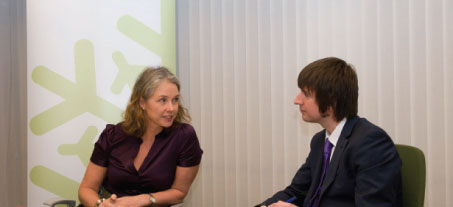
Chetkovich: “We have developed a new vision and values, and have introduced changes in Swedavia’s corporate culture. We have also started changes related to our brand – we shall connect our airports more closely to Swedavia, developing Swedavia into one entity.”
If you have visited Stockholm Arlanda airport in recent times, you have surely noticed some of its unmistakably attractive Swedish qualities – bright, spacious design, natural wood flooring and bountiful, comfortable seats to name but three. Even if you are surrounded by freezing, hostile weather outside, a warm welcome is firmly on offer once you arrive inside the airport. As first impressions of a country and its culture go, it’s quite an impressive start.
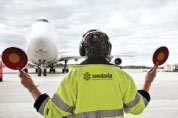
The division of LFV Group into two separate entities – LFV keeps air traffic management and a new company, Swedavia operates the airports – now allows each to concentrate on its main business and ushers in a newly revitalised and more dynamic business approach.
To give you some background, Sweden’s airports and air traffic management were jointly run by LFV for more than 60 years, from 1947 until earlier this year. The division of the organisation into two separate entities – LFV keeps air traffic management and a new company, Swedavia operates the airports – now allows each to concentrate on its main business and ushers in a newly revitalised and more dynamic business approach. Torborg Chetkovich, Swedavia’s CEO said “For both parties – LFV and Swedavia – there will be a greater focus on core activities. However, it is important to work in close partnership and our improved deliveries to customers are dependent on our joint improvements,” adding “the Swedavia Board includes members who have worked in various parts of the private sector, as well as airline experience. We – the airports – now have the efficiencies of the private sector, which allows for much quicker decision-making.”
Swedavia’s 13 airports handle 80% of the country’s air traffic, with the largest airport – Stockholm Arlanda – handling almost 16 million passengers in 2009. Chetkovich explained that passenger numbers have exceeded expectations in 2010. “The first six months were good, and the following months have been fantastic. We have seen double-digit growth in European and intercontinental traffic,” she said. “The outlook for 2011 looks promising. Our first indication – airport slot requests – shows expanded capacity at Stockholm Arlanda Airport.”
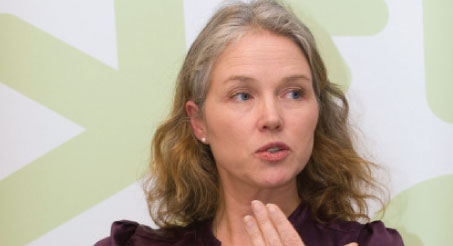
Chetkovich: “The airports are extremely important for their regions, for both tourism and business purposes. It is important for Swedavia to work closely with the regions, which are very proud of their airports. Incoming tourism is growing strongly and Swedavia is keen to support the development of the regions and their airports.”
Chetkovich was appointed as Swedavia CEO on 1 September and has been proactive in fulfilling her first priority of getting to know the operations and organisation, having visited 12 of the 13 airports at the time of writing. “We have developed a new vision and new values, and have introduced changes in Swedavia’s corporate culture. We have also started changes related to our brand – we shall connect our airports more closely to Swedavia, developing Swedavia into one entity,” she commented. “We have to accept that some of the airports will be loss-making entities as Sweden is dependent on air transport, but we will try to minimise those losses. Sweden has a small population of around nine million, but a large geography. The airports are extremely important for our regions, for both tourism and business purposes. It is important for Swedavia to work closely with the regions, which are very proud of their airports. Incoming tourism is growing strongly and Swedavia is keen to support the development of the regions and their airports.”
Under the new structure, the 4 biggest airports – Stockholm Arlanda, Göteborg Landvetter, Bromma Stockholm and Malmö – are their own profit centres, with the remainder grouped into one unit – regional airports. Ultimately, Swedavia will manage 10 state-owned airports, which Chetkovich described as the “national basic airport infrastructure”. Three airports are to be sold – Ängelholm Helsingborg, Sundsvall-Härnösand and Örnsköldsvik. Meanwhile, Karlstad Airport was sold on 1 December.
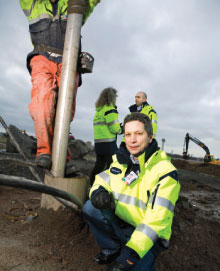
Swedavia demonstrates excellence in terms of environmental efficiencies. The aquifer at Stockholm-Arlanda provides significant energy savings. Acting as an energy storage unit, the aquifer is like a large thermos with water cooled during the winter and used as a cooling agent in the summer, and heat stored during the summer and used in the winter.
“Our strategic focus is that safety, efficiency and sustainable development shall be integrated into Swedavia’s operations. Swedavia shall be an employer distinguished by a culture that continually develops its employees and its operations,” explained Chetkovich. Current development plans include a hotel and airport city at Stockholm Arlanda, as well as investment in additional intercontinental terminal capacity at the airport; development of commercial terminal space and an airport city at Göteborg Landvetter; and expansion of capacity at Bromma Stockholm.
Meanwhile, Swedavia has started planning for the tender of local air traffic control at each of its airports. Control tower services are subject to competition in Sweden and competition is expected from further afield than just Sweden itself. Requests for information (RFI) will be sent out no later than Q1 2011 and the full tender documents during Q2 2011. Chetkovich said “We are aiming at having a functional tender with goal orientation rather than regulating details. The Swedish State is a professional owner with clear goals and objectives regarding financial performance. The owner will have explicit requirements and expectations.”
Commercial Development
Another priority has been meeting the management of Swedavia’s airline customers and Chetkovich emphasised the importance of the airline industry in supporting ‘mutual growth’ – both for leisure and business purposes.
The new Swedavia vision is: ‘Together we will bring the world closer’. This means airport employees working together with partners such as the airlines to increase accessibility and air travel to and from Sweden. “Ultimately, it is the decision of the airlines, but we will encourage them to open new direct routes. We will do this through relationship marketing, regional cooperation and attractive pricing models,” said Chetkovich.
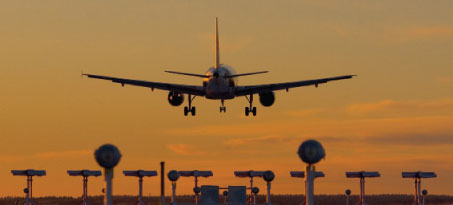
A key priority has been meeting the management of Swedavia’s airline customers and Chetkovich emphasised the importance of the airline industry in supporting mutual growth – both for leisure and business purposes.
Swedavia is working to increase customer value – for airlines, travellers and tenants. Development of commercial operations is key; in the years to come, this segment is expected to generate greater revenues for Swedavia than the aeronautical segment. “The greatest improvement in earnings will come from retail, food & beverage and property development,” commented Chetkovich. “We need to focus on commercial activities – that is how we are going to make money. In terms of market position, it is a constant challenge keeping down the costs to airlines. We are striving to be creative with our commercial activities – thinking outside the box.”
Arlanda Schiphol Development Company (ASDC) – a subsidiary of Swedavia – is 60% owned by Swedavia and 40% owned by the Schiphol Group, which of course operates Amsterdam Airport Schiphol. ASDC develops the commercial operations at each of Stockholm Arlanda’s terminals, as well as the SkyCity facility at the centre of the airport.
Exemplary Environmental Strategy
Sweden’s airports have long been exemplary in their approach to the environment and minimising the environmental impact of their operations, and development continues to be a priority. Stockholm Arlanda was the first airport to be accredited at the ‘Neutrality’ level (the highest level possible) of Airport Carbon Accreditation and Bromma Stockholm, Umea City and most recently Göteborg Landvetter Airport have followed. “Concern for the environment is taken into account in all our decisions. We have worked with environmental issues as a prerequisite for our operations – just as we do with safety and security – and have not seen this as a restriction,” said Chetkovich. “We can also demonstrate that our environmental efforts help to improve the bottom line. For instance, through energy savings at Swedavia and the aquifer at Stockholm Arlanda. Our objective is that ultimately, all of our airports will be Airport Carbon Accredited.”
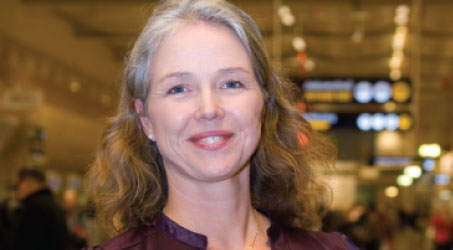
Chetkovich: “Concern for the environment is taken into account in all our decisions. We have worked with environmental issues as a prerequisite for our operations – just as we do with safety and security – and have not seen this as a restriction.”
In this framework, a key environmental target is the reduction of Swedavia’s carbon dioxide emissions to zero by 2020. The organisation is reducing its energy consumption, renewing its vehicles and fuels, and encouraging the use of public transport to access its airports. “We want to play an active role in providing a balanced view of the benefits of aviation and its environmental efforts. Aviation is not an environmental villain,” commented Chetkovich. “Our message is that we have a licence-to-grow perspective – that is, to develop our airports so that we create accessibility and competitiveness, but with clear responsibility for the environment, where we do everything we can to minimise our impact.”
Crucially, there is a limit to the level of CO2 that Stockholm Arlanda is permitted to emit – set by the Supreme Court of Sweden. From June 2011, neither the airport’s carbon dioxide nor nitrogen oxide emissions may exceed 1990 levels. Swedavia is currently working on an application for a new environmental permit, which it will submit by the end of 2010. While the airport’s emissions are currently below 1990 levels, the limit may present a problem with regards to future growth and the way emissions are calculated also presents a challenge – vehicle emissions, for example, are calculated based on the access journey of travellers and other users, to and from the airport. “It is dangerous for the competitiveness of our country,” asserted Chetkovich. “We’d like to grow and lift the CO2 ceiling, so a judge will review the limit independently. Traffic will just move to other hubs like Copenhagen and Helsinki, so there will be no CO2 saving in real terms. If there is no new licence, we will have to reduce air services.”
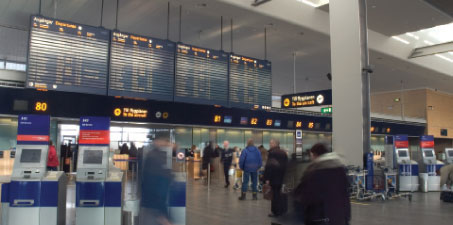
Swedavia’s 13 airports handle 80% of the country’s air traffic, with the largest airport – Stockholm-Arlanda – handling almost 16 million passengers in 2009. Chetkovich explained that passenger numbers have exceeded expectations in 2010.
Swedavia is working with Arlanda Express to see what can be done to further increase public transport access, and is also looking into allowing other train operators to stop at Stockholm Arlanda, which they are not currently allowed to do. It is, similarly, engaging with the taxi industry and aims to have only environmentally friendly taxis operating at Stockholm Arlanda by the end of 2011. Indeed, 80% of taxis currently operating at the airport already run on environmentally friendly fuels. “We are really driving this. These taxis are operating all over Stockholm, so the taxis all over the city have changed because of our initiative here at the airport!” explained Chetkovich. “We are also discussing an environment toll at Stockholm Arlanda – a potential charge of around €10 for cars to pass through the airport if they are not environmentally friendly. We aim to have that in place in Q1 2011.” A significant proportion of Swedavia’s commercial revenues are generated from parking and while these initiatives would undoubtedly impact on that revenue, Chetkovich believes it is necessary to achieve the organisation’s environmental goals. It is a view that further highlights Swedavia’s strong environmental commitment and their innovative approach to non-aeronautical revenues.
Sweden’s largest biogas station was also opened at Stockholm Arlanda in November. Anyone with a car than runs on biogas will be able to refuel at the station, which has capacity for six vehicles at a time. Several taxi companies also use the station. It is the second such biogas station – the first opened at Göteborg Landvetter Airport in August.
Prioritising accessibility
Chetkovich has extensive experience of working in public transport – prior to taking up her position at Swedavia, she was CEO of the underground transit operator MTR in Stockholm. And before that she worked with Veolia Transport – a public transport provider with a network across 60 countries, including Sweden. “Moving over to aviation and airports feels like a completely natural step for me. I have almost 20 years of experience working with railbound traffic – now it will be exciting to be involved in developing public transport in the air,” she said. “Air travel plays a key role in creating accessibility to Sweden. We were all able to see and experience the great importance aviation has for our country during the ban on flights due to volcanic ash.”
There are synergies, as Swedavia wants to connect air travel to other forms of public transport. Chetkovich developed a sharp focus on travellers and customer service at MTR and this will similarly form a key part of her strategy at Swedavia. She views creating accessibility as an important social task and Swedavia is working to create good contacts between the various stakeholders – operators and infrastructure providers.
Swedavia’s strategies for growth include: increased institutional, increased profile at travel and tourism events, increasing the share of intercontinental traffic, attracting low-cost carriers, incentive charges programmes and market support, and improving cargo capacity and facilities. Chetkovich sees the biggest potential for expansion in international flights – to both Schengen and non-Schengen countries. There is substantial demand for intercontinental routes and any new capacity made available is reportedly snapped up quite quickly. The domestic market, meanwhile, is quite mature and no major growth in passenger volume is expected. Consequently, Swedavia is investing its time and energy, together with its national and regional partners, to help develop and market inbound tourism to Sweden.
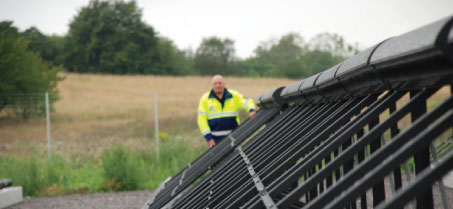
The solar heat installation at Malmo. Chetkovich: “Our message is that we have a licence-to-grow perspective – that is, to develop our airports so that we create accessibility and competitiveness, but with clear responsibility for the environment, where we do everything we can to minimise our impact.”
“We are working hard to expand the number of intercontinental routes into Stockholm and Gothenburg. The Swedish industry is quite clear about its expectations regarding direct routes and accessibility to other important regions of the world. It is important that we take part in campaigns to increase our region’s competitive edge compared to counterparts in other regions,” said Chetkovich. “We are also discussing expansion plans with the carriers based in our region. Norwegian is putting new capacity into our airports, and we are of course supporting them with information on market development and preferences.”
While new international traffic is a key element of Swedavia’s route development strategy, it is also looking to increase tourist traffic to its regional airports through attracting low-cost carriers. However, the Swedavia strategy does not currently include any plans for a dedicated low-cost terminal facility. “We have capacity at our regional airports and are looking at incentive schemes and market support,” commented Chetkovich.
So, all change for Swedish aviation. The division of air traffic management and airport operations in Sweden marks a line in the sand (or perhaps, the snow). Aside from the all-new strategic elements and the private sector efficiencies, Swedavia is already on its way to being a strong brand, set to become a major player in the Scandinavian and European aviation sectors. Conversation with Ms Chetkovich reveals that Swedavia has very ambitious plans for the years ahead – with more travellers and a wider array of carriers firmly in its sights. It is aiming for a strengthened position in terms of the intercontinental air routes that are so crucial to the development of the Swedish economy, as well as expanding through increased transfer traffic. All of this, alongside the aim of boosting non-aeronautical revenues and a keen desire to maintain their reputation for developing airports that are environmentally smart.







